Hummingbirds are perhaps one of the most fascinating bird species globally. They are mostly seen darting from plant to plant, feeding on what they love most - nectar! But can these beautiful birds be found in the UK?
Hummingbirds are native to the Americas and not found in the UK. However, the UK hosts hummingbird hawk-moths, which resemble hummingbirds but are insects.
Whilst the UK isn't home to hummingbirds, the equally fascinating mimic, the Hummingbird hawk-moth (Macroglossum stellatarum) is a fascinating insect with a lot of similarities to hummingbirds.
Below, we will share some interesting facts about these remarkable moths, including when are where you can see them, along with what can help attract them, as well as why hummingbirds just wouldn't be suited to the UK.
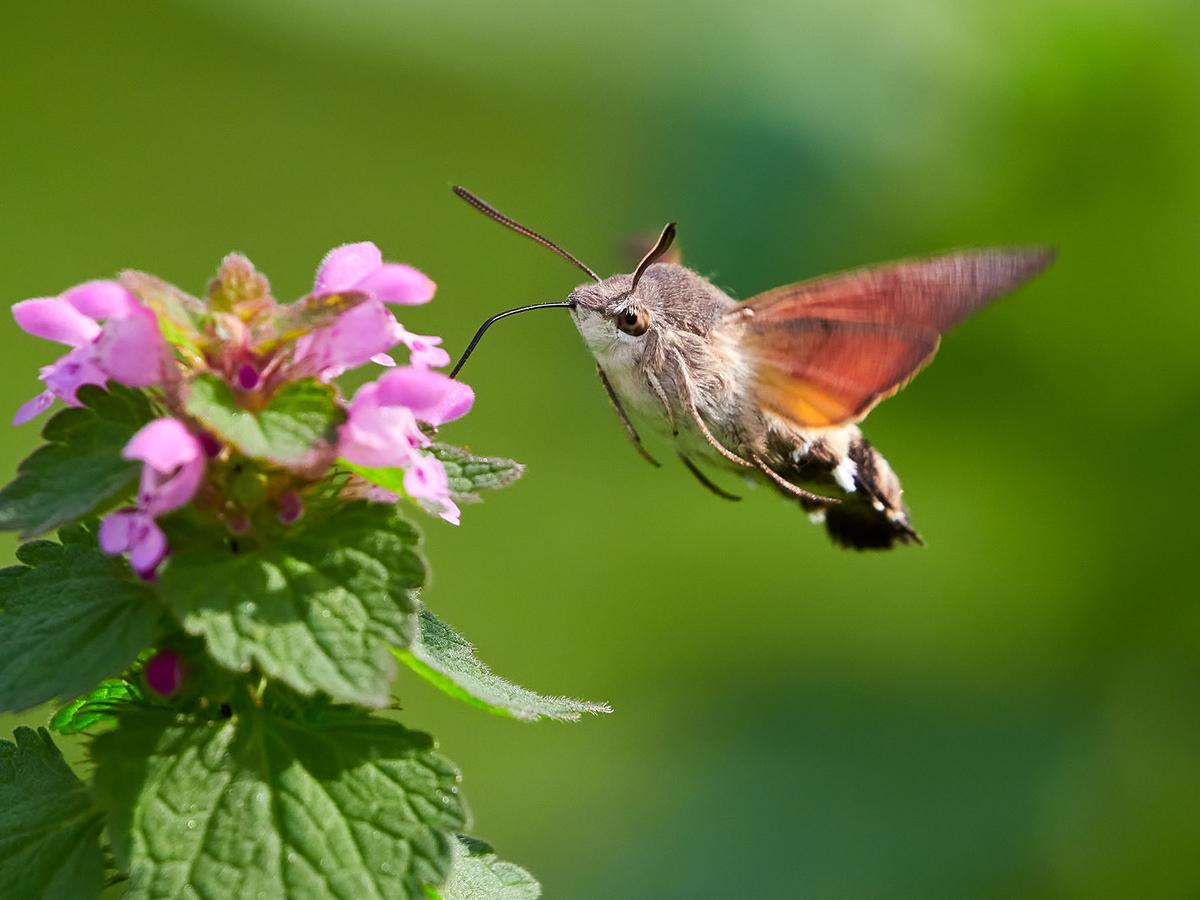
Close up of a Hummingbird hawk-moth (Macroglossum stellatarum)
Hummingbird Hawk-Moth: An Introduction
What are hummingbird hawk-moths?
Hummingbird hawk-moths are insects native to the UK, known for their remarkable resemblance to hummingbirds. With rapid wing beats, they hover in front of flowers to feed on nectar, mimicking the hummingbird's flight. Unlike their avian counterparts, these moths have antennae and a long proboscis for feeding.
They are named for their similarity towards hummingbirds, which they feed on nectar from tube-shaped flowers whilst hovering in the air, using their long proboscis.
Even though hummingbirds are overall one of the smallest group of birds in the world, Hummingbird hawk-moths are significantly smaller than the tiniest hummingbird, and smallest bird in the world, the Bee hummingbird.
Hummingbird hawk-moths are a strong flying species of hawk moth found across parts of Europe. They are mainly a greyish-brown colour, with orange markings on their wings. Their wingspan is usually around two inches (50 - 58mm).
These moths fly during the day and are often spotted in gardens flying from flower to flower. Their rapid wing beating produces an audible humming sound, with wings appearing blurred due to how fast they beat.
You're not alone if you've ever mistaken one of these moths for a hummingbird, as hundreds of people make this same mistake each year.
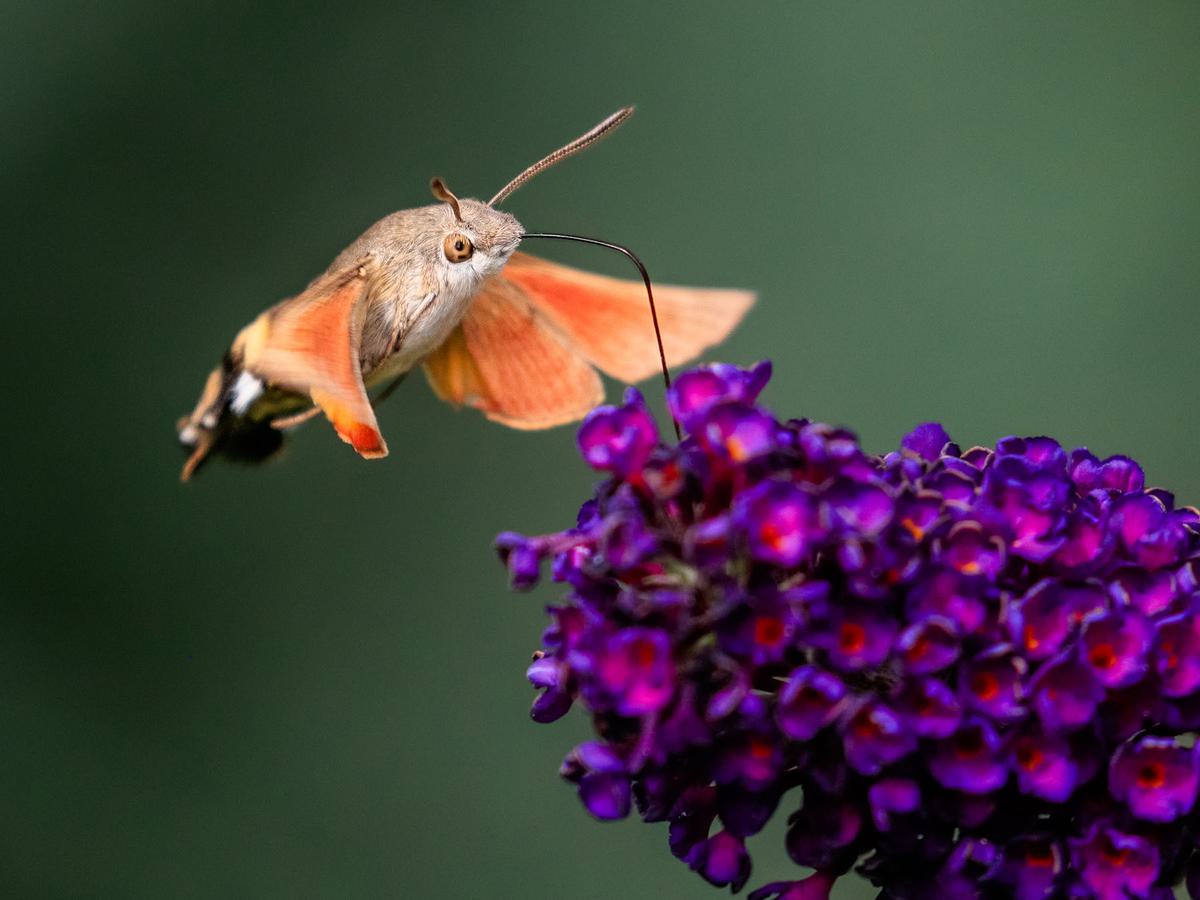
Hummingbird hawk-moth hoverings around flowering summer lilac (butterfly bush)
Where are they commonly spotted in the UK?
Hummingbird hawk-moths can be spotted in most parts of the UK each year, with the highest numbers in the southeast and near the coast. Sightings have been recorded as high up as both the Orkney and Shetland Isles.
As well as being spotted in gardens, they can also be found along the edges of woodland and on heathland.
Time of year
Hummingbird hawk-moths are most numerous between June and September, but they can be seen from April through to December, albeit in smaller numbers.
They are generally summer visitors to the UK, migrating from parts of Southern Europe in variable numbers each year. Only during mild winters will small populations overwinter here in the UK.
Hummingbird hawk-moths regularly breed in the UK each year, with the majority of larvae recorded between July and August. This is the reason for the higher numbers up until September, as the locally raised moths emerge.
Time of day
Hummingbird hawk-moths are most active during the day, but sometimes they can be spotted during the night. They show a preference for flying on bright sunny days, but will also take flight during dull days, and even sometimes at dawn and dusk.
They have a surprisingly good memory and will often revisit the same flowerbeds daily, usually around the same time.

Close up shot of a Hummingbird hawk-moth feeding on a butterfly bush
Comparing Flight Patterns
Whenever you see a hummingbird hawk-moth in flight, it's always a pretty amazing thing to watch and is strikingly reminiscent of the flight patterns exhibited by hummingbirds. They both have this unique ability to hover perfectly in mid-air whilst making fine adjustments with their rapid wing beats.
Perhaps the most essential part of this hovering ability is that they can feed with precision from tube-shaped flowers, similar to a helicopter hovering in place. The rapid wing beats allow them to hover stationary in front of flowers, even during windy days.
Flight pattern and wing differences
Although at first glance, hummingbirds and hummingbird hawk-moths may look remarkably similar in their flight pattern, there are, in fact, several distinct differences.
Hummingbirds achieve their hovering ability by flapping their wings at up to 80 times per second, in a figure of eight movement. Because hummingbirds have strong breast muscles, which can even be up to 30% of their body weight, they're able to facilitate this rapid movement. This also brings excellent manoeuvrability to hummingbirds, allowing them to fly backwards, forwards, and even upside-down!
Hummingbird hawk-moths are an insect and have entirely different wing structures and movement mechanisms. The wing movement is more of a circular movement, which gives them much more of a limited range of motion compared to hummingbirds.
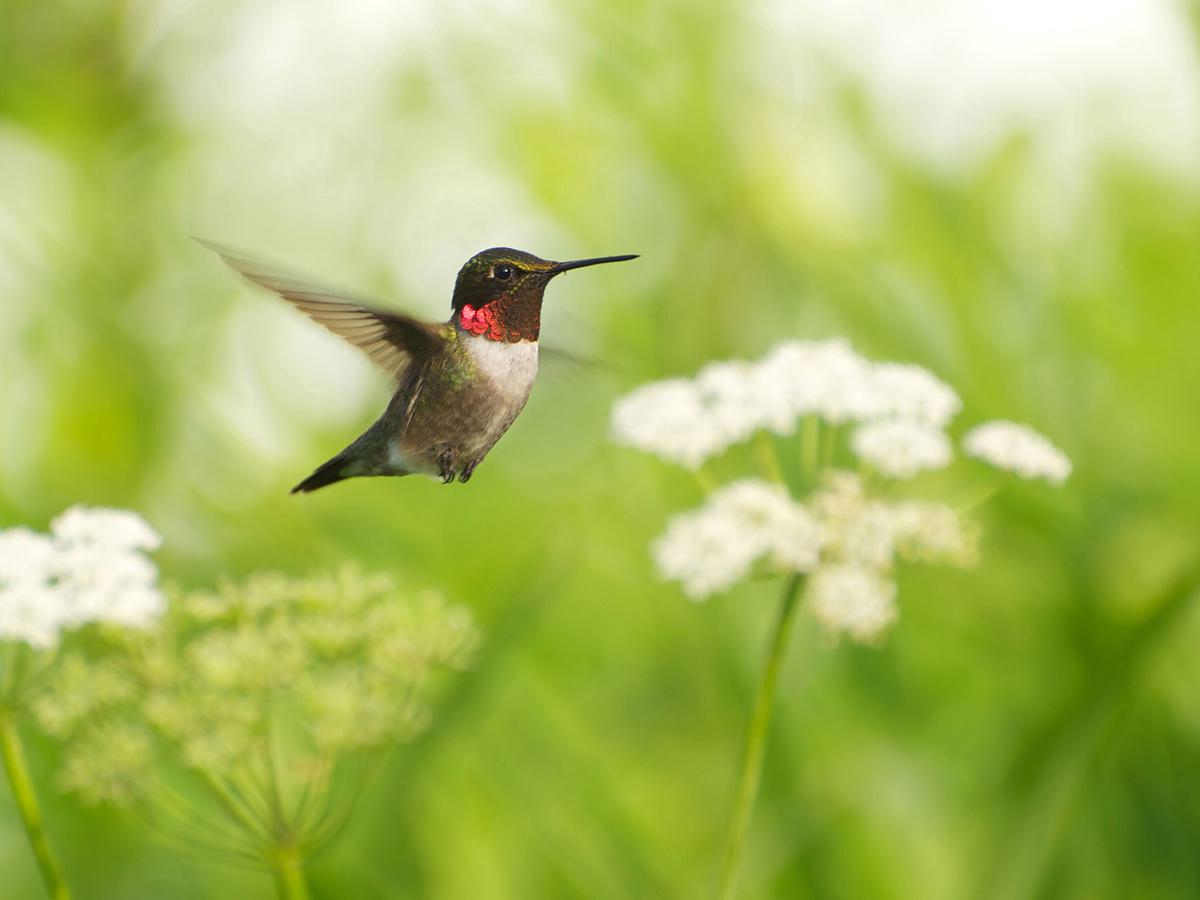
Hummingbird hovering in flight
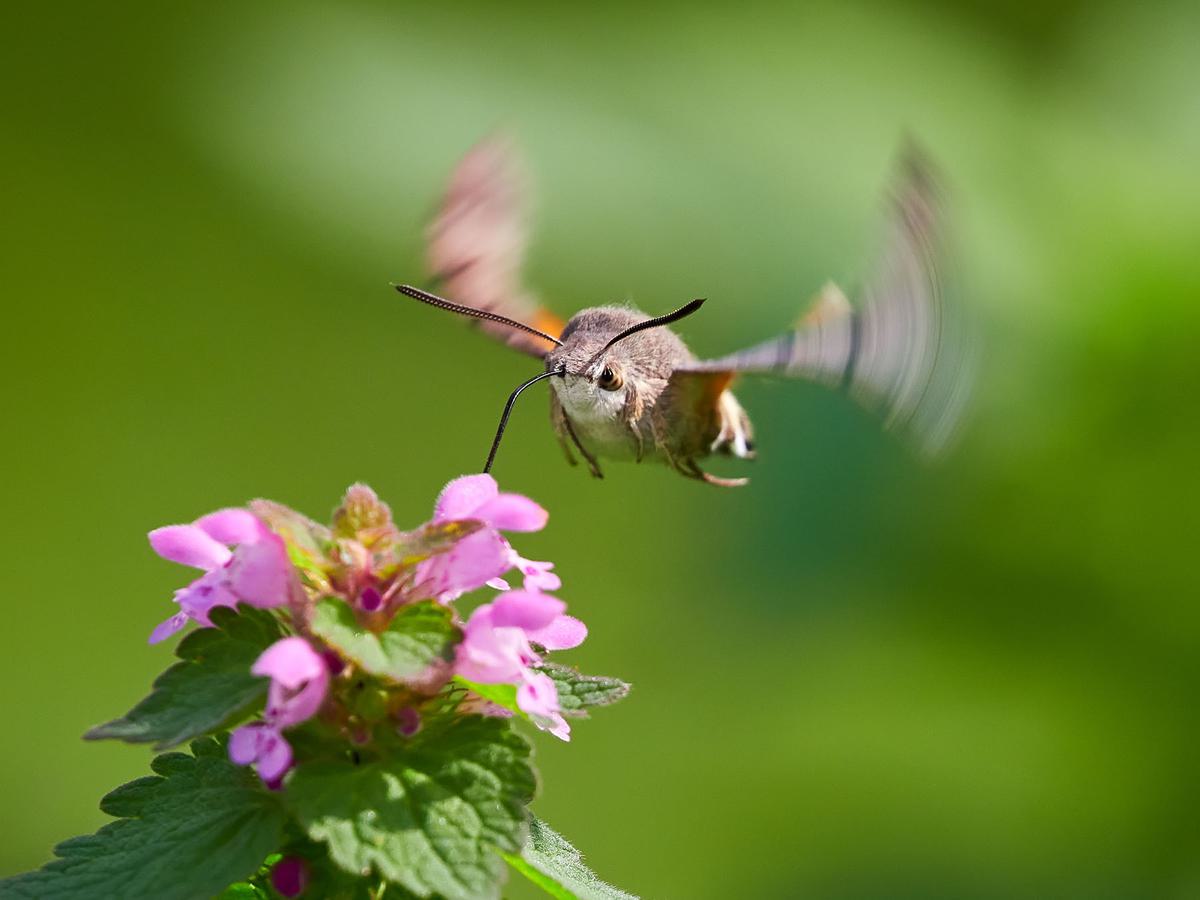
Hummingbird hawk-moth hovering in flight
Dietary Habits
Hummingbird hawk-moth's favourite food plant to feed on is both the Galium (bedstraw) and Rubia (wild madder). However, they show a preference for tubular shaped flowers that provide a plentiful supply of nectar.
Other flowers that can help attract hummingbird hawk-moths include:
- Red Valerian (Centranthus ruber): This is one of the most favoured flowers by hummingbird hawk-moths in the UK. It's a perennial plant with clusters of small red or pink flowers.
- Buddleia (often referred to as the "Butterfly Bush"): While it's renowned for attracting butterflies, its fragrant and vibrant-coloured flowers also attract hummingbird hawk-moths.
- Honeysuckle (Lonicera): This plant has sweet-scented, tubular flowers, making it a favourite for these moths.
- Nicotiana: Also known as flowering tobacco, its tubular flowers, especially the species Nicotiana alata, are attractive to the moths.
- Petunia: This popular bedding plant, especially the brightly coloured varieties, can lure in hummingbird hawk-moths.
- Verbena: Especially the tall verbena (Verbena bonariensis), which has clusters of small purple flowers.
- Phlox: Many varieties of phlox have fragrant flowers that can attract the moths.
- Hebe: This plant offers spires of nectar-rich flowers, typically in shades of blue, pink, or white.
- Lavender: Not only does lavender attract bees and butterflies, but its fragrant flowers are also a favourite of hummingbird hawk-moths.
- Salvia: Especially red or purple flowering varieties, as they have nectar-rich tubular flowers.
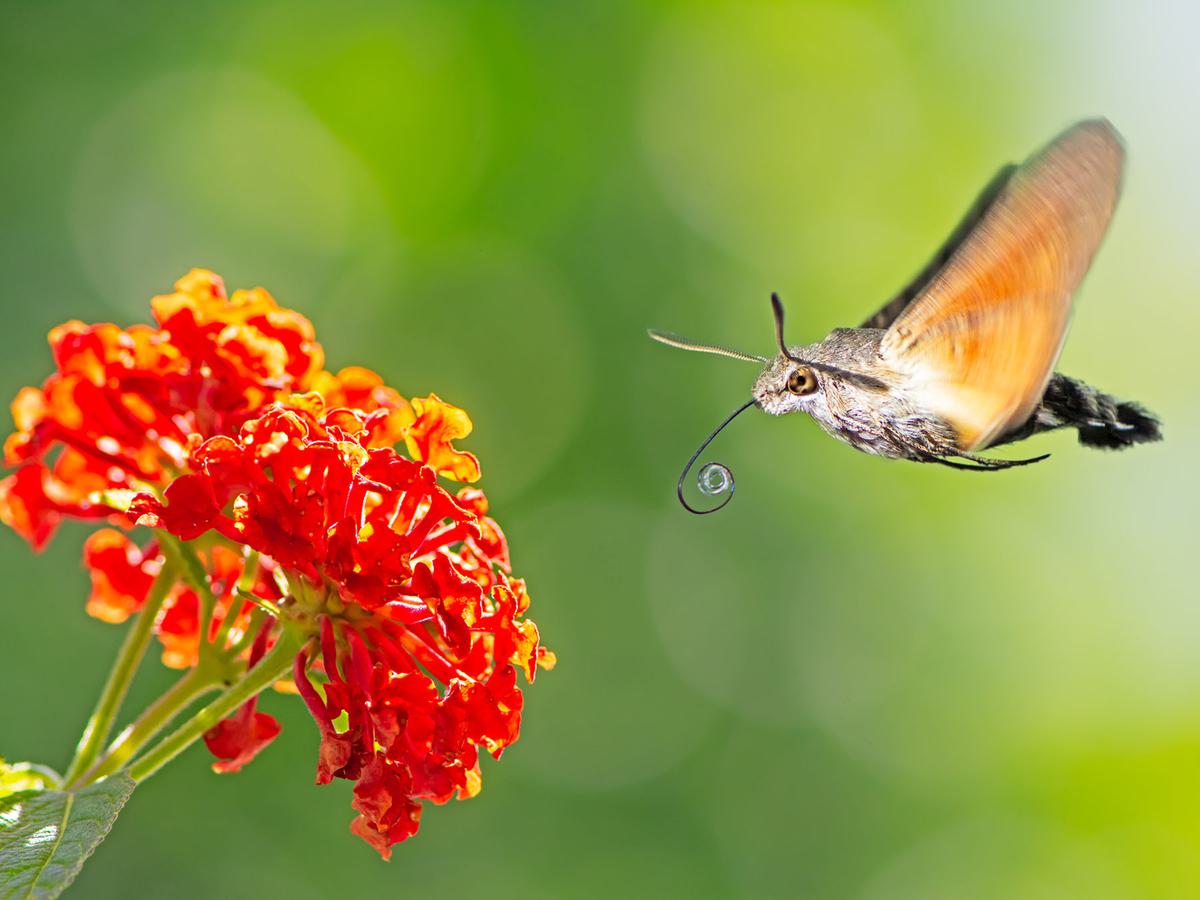
Hummingbird hawk-moth flying to a orange lantana flower
The Global Spread of Hummingbirds
Where are hummingbirds commonly found?
Hummingbirds are native species to just the Americas, with most of the species inhabiting tropical and subtropical parts of Central and South America.
North America is home to many hummingbird species as well, but mainly during the warmer summer months, when they'll make their remarkable migration northward for breeding.
The Rufous hummingbirds have one of the most remarkable migration journies, which you can learn about in this Rufous hummingbird migration guide.
In terms of habitat preference, hummingbirds are highly adaptable and can be found across a diverse range of habitats, from rainforests and coastal areas to deserts and mountainous regions.
Continue reading to find out why hummingbirds aren't suited to places like the UK.

Close up of a stunning Sparkling violetear (Colibri coruscans
Why don't they inhabit places like the UK?
There are several reasons which contribute to hummingbirds' absence in places like the UK:
Climate
Hummingbirds need to maintain high energy levels, and their high metabolism requires a steady intake of food, which is primarily nectar. The cooler climate of the UK would make it much more difficult for them to maintain their energy levels, particularly during the winter months.
Historical Distribution
Hummingbirds evolved in the Americas, which meant they naturally never spread to other continents. Over this long period, they've adapted to the specific ecosystems which are unique to this part of the world.
Dietary Needs
The specific types of flowers that hummingbirds show a preference for (in terms of shape, colour and nectar production) are mainly found in the Americas and have co-evolved with them. The UK does have many flower types, but would generally not be as well suited as those found in the Americas.
Predation & Competition
Over time, hummingbirds have learned to deal with any threats and predators within their natural range. Introducing them into a new place could mean dealing with new competition and predators that they're not naturally used to, making survival harder.
Migration Patterns
The known migration patterns of hummingbirds, particularly those in North America, are oriented north-south between their breeding and wintering grounds, both of which are in the Americas.
FAQs
What is the hummingbird like creature in the UK?
Hummingbird-like creatures in the UK are Hummingbird hawk-moths. Although from a glance, they may look like a hummingbird, they're actually insects.
